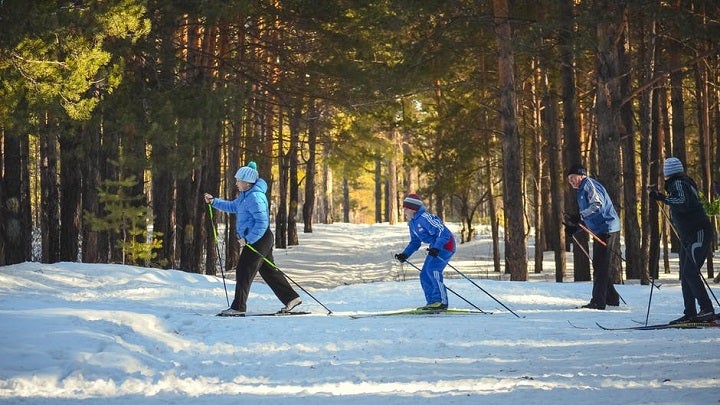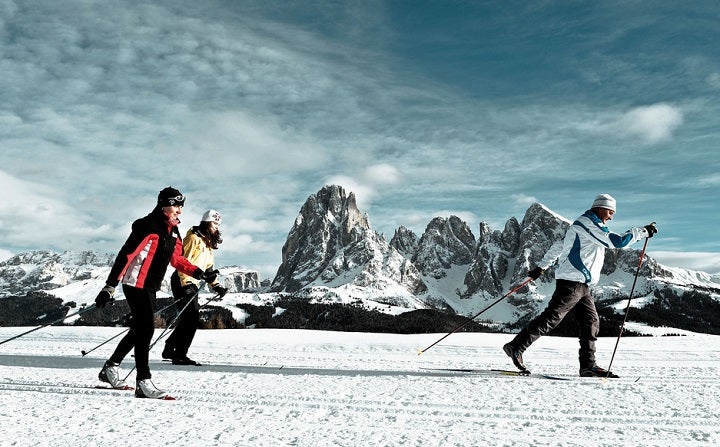
Our Editors independently research, test, and rate what we feel are the best products. We use affiliate links and may receive a small commission on purchases.
Growing up in lower Michigan meant that I never got a chance to learn alpine skiing until I was in college. As a kid, I worked for a local park and learned to cross country ski on the job.
We rented skis and maintained several miles of groomed Nordic skiing track. Eventually skate skiing became all the rage and today it seems cross country skiers enjoy both types of skiing equally.
Among the methods of winter travel, cross country skiing may be the most fun for traveling. It can be surprisingly efficient, exciting, and quick.
There are big differences between breaking your own trails and skiing on groomed trails, too. We’re going to talk about how you can get started and what you need to know to enjoy your time cross country skiing!
Getting Your First Pair of Cross Country Skis
Types of Cross Country Skis
For recreational skiers, there are basically two three types of skis you’ll need to worry about. They are: touring skis, metal-edge touring skis, and skate skis. Here are some good beginner ski packages I can recommend.
Touring Skis
These skis are specifically designed for use in set track. They’re lightweight skis and tend to be longer than most other types. These are ideal for the local groomed trails and they’re by far the most common type of cross country ski you’ll encounter.
Metal-edge Touring Skis
As the name implies these skis are quite similar to touring skis. They differ in that they are made for steeper angled terrain and out-of-track skiing. They’re usually a bit wider and shorter than true touring skis which gives them more agility and maneuverability. They also have greater sidecut for turning and perform more similarly to alpine skis.
Skate Skis
These types of cross country skis are made for an entirely different approach. They’re only to be used on groomed trails and the trails must be made for skating. These skis are designed to kick and glide with maximum ease and they’re used similarly to ice skates.

To Wax Poetic… Or Not?
Cross country skis come in two basic flavors. There are waxless skis, and there are waxed skis. Mind boggling, I know!
So, what’s the difference? Waxless skis take much less maintenance, less tools, and less expertise to keep up. In fact, they usually require practically zero attention between trips. Their downfall is that they’re a little less efficient and versatile when compared to waxed skis.
Waxed skis require a fresh coat of wax on regular schedules to maintain their effectiveness. These waxes are chosen based on the temperature of the snow and predicted weather conditions.
Choosing the wrong wax can be disastrous! Waxes are relatively pricey and constantly having to hassle with melting wax and maintaining a workstation for your skis can be a daunting prospect to many skiers.
Choosing between these two types of skis is generally an easy call for most. Far and away the majority of skiers go with waxless skis. Keep in mind that waxless skis still need occasional applications of “glide wax” but this can simply be rubbed on like a deodorant stick and takes only seconds.
How Big of a Ski Do I Need?
Luckily most manufacturers have a simple scale based on user height and weight. This means all you have to do is pick a ski that meets your body type requirements and you’re good to go!
For more advanced users, you may want to seek deeper features.
Choosing a ski with shorter length will increase agility but sacrifice some speed and flotation. Longer skis, then, tend to be faster in track but much less agile for maneuvering.
Skis also come in various widths. Keep your skis under ~65mm wide in order to ensure that they fit easily into all set tracks. For off-trail use, feel free to go with as wide of a ski as you feel comfortable with.
Cross Country Ski Poles
By and large, cross country ski poles need not be expensive purchases. Entry level models often come with the skis and if you want better poles upgrades can be quite affordable. Aside from weight, the handle design and shape is an important upgrade factor.
Look for cross country ski poles that are as lightweight as your budget will allow. You’ll also want to find ones with ergonomic handles and comfortable straps. The straps will be used to help you get some extra push when you kick and glide, so comfy straps are a must!
For classic cross country skiing you’ll want a pole that’s approximately as long as your shoulders are tall. A pole which sits snugly under your armpits when standing is properly sized.
For skate skiing a pole which is neck high or even taller sometimes can be appropriate. These longer poles help you get more push between each kick and maintain momentum through your movement.
Cross Country Ski Boots
There are several different types of cross country ski boots but one easy way to avoid problems. While picky users can choose their skis, ski boots, and poles separately it just makes sense to buy a package.
At the very least buy your skis and boots in a package as a beginner to avoid fitment problems. Like any footwear, however, be sure to go get yourself sized and fitted at an outfitter. There’s just no good way to tell if a shoe or boot will fit from an online sizing chart.
Once you find a brand you like and a boot size that fits comfortable just buy your boots and skis together as a package either online or from a shop.
Make sure your boots and skis match! There are two types of ski bindings, NNN and SNS. New Nordic Norm bindings will only work the matching type of ski boot. Salomon Nordic System bindings, as you guessed, also only work with SNS boots.
That’s why it’s just easier to buy a packaged set.
Video: How to choose cross country skis and boots.
Clothing and Layering
Choosing the right clothes for cross country skiing can be hard. Unlike downhill skiing, cross country skiing always works up a big sweat. But you’re outside during the winter and this create a problem.
To avoid getting overly wet and sweaty and then cold, make sure to wear a lightweight base layering system. You’ll want to dress as if it’s much warmer than it is, or you’ll end up soaked in sweat instantly!
My advice is to wear thin polyester base layers with zippered necklines. These can be adjusted easily to warm you up or cool you down. For an outer layer, you can wear a thicker fleece and / or a outer ski jacket shell to keep the weather off of you when it gets particularly nasty.
Whatever you do, don’t try cross country skiing in thick winter coats or thick insulated snow pants. You won’t enjoy the sweat-storm that results! Ski pant shells that have zippers for ventilation work well. When in doubt carry extra layers in your backpack and adjust on the go.
Conclusion
Getting started cross country skiing isn’t hard. The learning curve is light and new skiers can start on totally flat terrain. If you’ve never skied before it’s challenging and thrilling. You’ll find it to be much less intimidating than learning downhill skiing!
I recommend that all new skiers start out by renting equipment the first few times before buying. This allows you to find out if the sport is right for you. Plus you’ll be able to get a better sense of what gear you like and what to buy for yourself!
I hope this beginners guide to cross country skiing was helpful to get you started. If you want to comment or recommend a cross country skis or tips I didn’t include, please use my contact form to get in touch.
Have fun and be safe out there!
